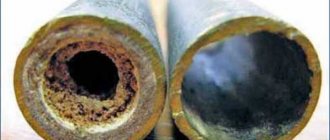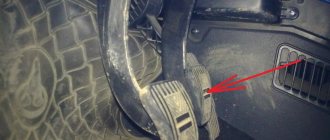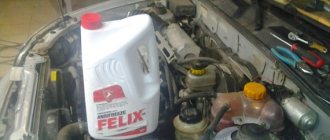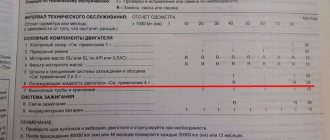Why does the Chevrolet Lanos stove heat poorly? We eliminate the reasons ourselves
Quite often, owners of this model have to find out why the Chevrolet Lanos stove does not heat well.
First, let's note: the heater works great, without any complaints from the owner. However, already after the season, problems begin that traditionally come to light with the onset of cold weather. Putting up with them is dangerous not only from the point of view of getting colds (which, by the way, is also unpleasant and always at the wrong time), but also from the point of view of traffic safety: the windows freeze, there is no visibility, and constantly wiping them off distracts you from the road, which is fraught with in an accident. The heater needs to be dealt with urgently, and I would like it to be done without extra costs. First of all, you need to find out what caused his abnormal behavior. We will tell you below why the Chevrolet Lanos stove does not heat well and how to eliminate sabotage on its part.
Coolant and problems with it
There may be 2 options: the coolant does not reach the required temperature
. The most common culprit for this is the thermostat: it breaks quite easily. It is not difficult to recognize it in this capacity: firstly, when the engine is warm, the coolant temperature gauge crawls extremely lazily to the desired place, and then stops before reaching the desired mark. Secondly, you can touch the pipes connecting the radiator and thermostat. If the latter malfunctions, they either heat up almost instantly (the stove has not yet reached 70°C, according to the instruments), or they will remain cold. There can be only one repair here: replacing the thermostat.
Low coolant flow through the radiator
. It can also be determined by touch: the output and input hoses have a sharp temperature difference (although it can also be observed for other reasons). One of the factors causing a drop in coolant pressure in the system is blockage of channels. In this case, you can try flushing the radiator. The simplest method is considered to be in which the pipes are removed, a pump is connected, and the washing solution is circulated in a circle using a bucket. If the problem is not in clogged channels, but directly in the radiator, it will have to be repaired or replaced.
Airing the radiator can also impede the circulation of coolant - it cannot break through the air plug. Symptoms - as in the previous paragraph. The treatment is most simple: drive your Chevrolet Lanos up a hill so that the nose lifts up at least 20°, unscrew the cap from the expansion tank and accelerate several times - the cap should disappear.
Radiator clogged from outside
This problem can be diagnosed by the same temperature of the stove pipes and a lower air flow coming out of the diffusers. In this case, the blockage does not occur instantly, but over a long period of time - a decrease in the flow force cannot be noticed immediately. It is best to check the flow strength in comparison with a working model. On a Lanos of any production, be it a Daewoo, Chevrolet or ZAZ, there is no cabin filter. The heater radiator, and with it the evaporator for the air conditioner, are easily clogged with various debris - it can be fluff, leaves, anything. Naturally, such a blockage does not allow air to pass through the radiator freely. And as a result, the Lanos stove does not heat well, and it becomes very uncomfortable in the car.
Also, after a while, the air conditioner may begin to “smell” in the absence of a cabin filter. This happens due to dust that accumulates during operation of the machine. It settles on the evaporator, thereby creating favorable conditions for the development of various microorganisms and harmful bacteria. Debris can be easily removed using an ordinary vacuum cleaner - to do this, dismantle the fan and insert a hose into the box without any attachments. At the same time, it is recommended to purify the system through diffusers.
Individual feature
Probably, only this model has a tendency to break off the radiator mount, which is a bracket that presses it to the air duct. After such an incident, cracks appear, and cold street air begins to flow into the cabin, bypassing the heated radiator. You can check your assumption by moving the radiator pipes under the hood - they must be motionless, otherwise you have the indicated situation.
The Chevrolet company orders the removal of the torpedo to eliminate the accident. However, many owners complain: such actions, in addition to being labor-intensive in themselves, often lead to problems with the reinstallation of removed elements. Complaints about the return of air ducts to their original location are especially strong. Craftsmen have developed a technique that allows for a minimum of dismantling.
- From the side of the engine compartment, a thick steel wire is wrapped around a circle of pipes near their very base and stretches down the body near the right (passenger side) side member - the crankcase protection is fixed there. When the pipes are pulled down, the stove itself moves up;
- The casing between the front seats is removable;
- Use a Phillips screwdriver with a figure-seven head to screw in 3 screws, remove the lower distribution cover, which is responsible for redirecting warm air to the legs;
- The 6 bolts holding the bottom box are removed. Its front part slopes down;
- Take a metal strip (preferably aluminum) 8 cm long, 1.5 cm wide and 3 mm. thick. It curves like an old doorknob. A hole with a cross-section of 7 mm is drilled into it, through which a bolt with a solid thread is inserted and secured with a nut with a nylon stopper. A bushing with an external thread and a fairly wide washer is screwed behind it;
- A hole is made in the lower box - a diameter of approximately 9 mm. – in front of the front wall of the radiator and strictly in the center;
- Using clamping tweezers, the created structure is pushed inside, and the end of the sleeve that appears from the outside is fixed with a nut;
- The support plate is similarly oriented parallel to the radiator tank and, by rotating the end of the bolt located outside, rests against the radiator.
How to fix poor heating of the stove on a Chevrolet Lanos
With the onset of cold weather, mechanics at service stations very often hear the same problem: the stove on a Chevrolet Lanos heats poorly or does not heat at all. Let us note right away that this is one of the “diseases” of this car. The heater on the car is not designed in the best way. Even a working stove does not heat quite as well as we would like. And all because the car was not designed for the harsh Russian winter.
So, in your Chevrolet Lanos the heater is blowing cold air, and you are freezing and constantly scrubbing the windows, you are nervous. Of course, the situation is disgusting, even dangerous, and requires immediate correction.
There are quite a few reasons why the stove does not heat up on a Chevrolet Lanos. Let's look at the most common of them.
The thermostat has failed
The second reason why the stove does not heat well on a Chevrolet Lanos is a broken thermostat. This device is quite fragile and easily breaks down. How to recognize that the thermostat is broken? When the engine is warm, the antifreeze temperature needle will rise very slowly and not reach the desired value. Also touch the pipes connecting the radiator and thermostat. They will either heat up very quickly (although the stove, according to the sensors, has not yet warmed up), or will remain cold. There is only one solution - replacing the thermostat.
Airiness of the system
The third possible failure is air in the system. Diagnosing this is also easy. In this case, in the engine compartment, the temperature of the inlet and outlet pipes of the heater radiator varies greatly. The fan turns on frequently. Removing air is not difficult. Go up the hill (by car, of course, at about an angle of 30 degrees), remove the expansion tank cap and press the gas pedal all the way down several times. Experts warn that after about a year, air may accumulate again, so carry out this procedure every autumn to avoid freezing in winter.
Heater radiator is clogged from inside
If the stove does not heat well on a Daewoo Lanos, then it is worth checking this unit directly. The hoses in the heating system give off a completely different temperature. The thermostat opens more often than necessary. The radiator fan also turns on frequently.
Why does the radiator clog? The reason for this may be the antifreeze that drivers pour into the system. If the fluid is of poor quality, deposits begin to form inside the lines. Most owners try to flush radiators and lines with phosphoric acid solutions, descaling agents, even Coca-Cola. And sometimes these methods help, but more often than not, washing does not give results. As a result, the stove still does not heat well (Lanos 1.5 is no exception). In garage or home conditions, the process of flushing the stove radiator is carried out using three pieces of hose and a warm solution of citric acid. In addition, an antifreeze test can be performed under such conditions. Liquid is poured into two containers. Then pour a little soda into one of the vessels. A little bit of any acid is added to another container. If no chemical reaction has started in either the first or second container, then the Lanos stove does not heat well, not because of the radiator - the antifreeze is of quite high quality.
Failure of fastening
The fifth reason is the most interesting. The design of the heater radiator mounting itself fails. High temperatures, poor quality plastic and heavy loads lead to the fact that the fixing bracket wears out and the radiator gradually breaks off from the air duct. It is not difficult to imagine that cold air then enters the cabin through the cracks. Here, no matter how hard your stove tries, there will be a glacier in the cabin.
At service stations, the reason why the stove on Lanos does not heat well is encountered quite often. Therefore, experts advise not to let things get into trouble and to additionally secure the fastening with self-tapping screws or hooks in advance. Please note that everything must be done carefully so as not to break the honeycomb. Then, if the stove on Lanos starts to heat up weakly, you won’t have to worry about the fastening breaking off.
Now you know almost all the probable reasons why the stove on a Chevrolet Lanos does not heat well, and you understand the intricacies of the heating system of this car no less than an expert. Having checked all the points indicated in the article before the onset of cold weather, you can with almost 100% probability not be afraid that your “swallow” will let you down in winter.
Air in the radiator
This is another reason why the stove does not heat well on the Chevrolet Lanos and other modifications of this model. With this malfunction, the temperature of the stove pipes will vary significantly, the fan will turn on more often, and the thermostat will open. In this case, removing excess air from the radiator is not an easy task. It is located in the ventilation system box at a certain angle. If you do not intentionally remove air, then at first the Lanos stove does not heat well, and then it may stop working altogether. You can try to remove the airiness entirely. To do this, you need a slide where the car can be placed at an angle of 30 degrees or more. It should be remembered that after some time the air pockets will return again, so the procedure should be repeated over time. This case is due to a jet falling into the expansion tank from the throttle heating system. When this same jet falls, air bubbles dissolve in the antifreeze and eventually spread throughout the system. Many whose Daewoo Lanos car's heater doesn't heat well have noticed that the problems started after the first year of owning the car. This malfunction can have two main causes: coolant, which was kindly added during assembly of the car, or bubbles.
Chevrolet Lanos heater does not heat: reasons
The simplest reason why the Chevrolet Lanos heater does not heat well is the failure of the fan due to a blown fuse. In the same way, the electric motor switch can fail. All that needs to be done in this case is to change the fuse responsible for the electric motor or fan. They cost pennies, but they change on their own within three minutes.
Another common reason why the stove on a Chevrolet Lanos does not heat well is airing in the cooling system. As a result, antifreeze does not circulate well through the system, and the heat exchanger does not heat up enough. In order to understand the reason for this or not, you need to touch the hoses at the inlet and outlet of the heating system. This whole thing is located under the hood, in the engine compartment. If both tubes are cold, you need to fix the problem. This is done extremely simply. It is enough to open the cap of the expansion tank, then make the car stand at an angle (on some incline, with the front facing up) and hold the engine at medium speed (in neutral gear) for a couple of minutes. As a result, all the air that was in the system will escape through the open expansion tank.
Why is cold air blowing from the stove in Lanos?
Basically, all control devices of this type are equipped with metal cables. At a certain point, the switch may get stuck in one position. At that moment, if the regulator is stuck in the “warm” position, then warm air will begin to flow into the cabin.
Its temperature will depend on the degree of opening of the damper at the moment of jamming. But if the damper control is stuck in the closed position, the stove blows cold air.
Regardless of what the controls and controls for the heater dampers and taps look like (lever, wheel, dial switch), the malfunction is the same.
Sometimes a compromise option partially helps - blowing the radiator with compressed air or flushing with water under pressure, and from different directions. It is unlikely that it will be possible to restore 100% heating efficiency in this way, but for Ukrainian winters this option may be quite acceptable.
Finally, the simplest case of inefficient operation of the heater in a Lanos is a break in the damper control cable. The subtlety is that, like most modern cars, Lanos does not have a heater tap.
That is, the radiator of its “stove” is hot all the time and the supply of hot air into the cabin is activated by dampers in the air ducts. Replacing the cables is done from inside the car and is generally a simple operation. In a word, there are many reasons for heater failure - but there are always solutions.
Why is cold air blowing from the stove in Lanos?
Attention In addition to dismantling all these components, you will have to rework the internal structure of the stove box. The entire system needs to be completely redesigned.
The heater on a Lanos car does not heat well: reasons
So, there are several typical faults that, according to owners, may be the reasons for the ineffective operation of the standard heating system.
Perhaps not all are described here, but the list is compiled based on the personal experience of lanosovodov.
Heater radiator is clogged from inside
If the stove does not heat well on a Daewoo Lanos, then it is worth checking this unit directly. The hoses in the heating system give off a completely different temperature.
The thermostat opens more often than necessary. The radiator fan also turns on frequently.
Why does the radiator clog? The reason for this may be the antifreeze that drivers pour into the system.
Why is cold air blowing from the stove in Lanos?
Unlike other brands in the budget segment, the Chevrolet Lanos is equipped with an autonomous heating system. Heating of the windshield and interior with a flow of warm air together with the air conditioning system. This design has advantages and disadvantages. Let's take a step-by-step look at why the stove on a Chevrolet Lanos does not heat well.
Why is cold air blowing from the stove in Lanos?
You need to open the cap of the expansion tank, drive the front of the car onto an elevation (embankment of the road, ramp of an inspection overpass) and let the engine run for several minutes at medium speed.
The flow of liquid will expel the air lock through the open expansion tank - a characteristic gurgling sound will even be heard in the cabin.
The fact is that in Lanos the heater radiator is located at an angle to the horizontal, and in order to raise the air plug to the highest point of the radiator, it must be tilted along with the car.
A more complex problem is the displacement of the heater core in the air duct. In cars produced in the second half of the 2000s, the clamps securing the heater radiator break. As a result, it warps and allows the bulk of the air to pass by it, i.e. stay cool.
This happens due to dust that accumulates during operation of the machine. It settles on the evaporator, thereby creating favorable conditions for the development of various microorganisms and harmful bacteria.
Debris can be easily removed using an ordinary vacuum cleaner - to do this, dismantle the fan and insert a hose into the box without any attachments. At the same time, it is recommended to purify the system through diffusers.
Air in the radiator
This is another reason why the stove does not heat well on the Chevrolet Lanos and other modifications of this model.
With this malfunction, the temperature of the stove pipes will vary significantly, the fan will turn on more often, and the thermostat will open. In this case, removing excess air from the radiator is not an easy task.
It is located in the ventilation system box at a certain angle.
If you do not intentionally remove air, then at first the Lanos stove does not heat well, and then it may stop working altogether. You can try to remove the airiness entirely. To do this, you need a slide where the car can be placed at an angle of 30 degrees or more.
It should be remembered that after some time the air pockets will return again, so the procedure should be repeated over time. This case is due to a jet falling into the expansion tank from the throttle heating system.
When this same jet falls, air bubbles dissolve in the antifreeze and eventually spread throughout the system. Many whose Daewoo Lanos car's heater doesn't heat well have noticed that the problems started after the first year of owning the car.
Important It is important to note that repairs are easier to carry out with a partner. This paragraph indicates the process of dismantling and installing the Kalina stove.
Step-by-step dismantling process:
- First you need to drain about three liters of coolant.
- To easily dismantle the radiator, remove the accelerator pedal and lift the brake pedal as high as possible.
- The steering column is removed.
First, remove the protective panels from the speaker. Then disconnect the electrical wiring plug from it.
- We disconnect the parts of the intermediate universal joint of the steering mechanism and unscrew the mounting bracket from the body.
You can solve the issue yourself. You need to open the cap of the expansion tank, drive the front of the car onto an elevation (embankment of the road, ramp of an inspection overpass) and let the engine run for several minutes at medium speed.
The flow of liquid will expel the air lock through the open expansion tank - a characteristic gurgling sound will even be heard in the cabin.
The fact is that in Lanos the heater radiator is located at an angle to the horizontal, and in order to raise the air plug to the highest point of the radiator, it must be tilted along with the car.
A more complex problem is the displacement of the heater core in the air duct. In cars produced in the second half of the 2000s, the clamps securing the heater radiator break. As a result, it warps and allows the bulk of the air to pass by it, i.e. stay cool.
Source: https://evabarbersop.ru/pochemu-na-lanose-iz-pechki-duet-holodnyj-vozduh
The Chevrolet Lanos stove still does not heat well. What to do?
If the tips described above did not help you, there is a possibility that the reason that the Chevrolet Lanos heater stopped heating could be a displacement of the radiator. In cars manufactured since 2004, the heater radiator mounting clamps often break. As a result, it warps a little, and the bulk of the warm air simply passes by it.
Chevrolet Lanos heater radiator
The second more complex breakdown is a clogged radiator. This occurs in older cars in which this radiator has never been replaced. There is only one way out - replacing the radiator.
The Chevrolet Lanos stove does not heat well video:
Early opening thermostat
Experienced owners, if the stove does not heat well (Chevrolet Lanos and Zaz Sens, among others), recommend checking the standard thermostat. The one installed in the car indicates its operating temperature (it is 86 degrees).
However, most often it opens and allows antifreeze to pass through much earlier. Why does the stove on the Lanos not heat well? Yes, because the coolant temperature is not yet sufficient, but it flowed through the engine through a small gap in the half-open thermostat. Antifreeze reaches the heater radiator unheated. This is clearly visible when the car is just warming up and the thermostat opens for the first time - the supplied air becomes even colder. The stove will heat the interior much better when the thermostat opens several times.
Heating system elements
- Radiator: warms up the air flow by circulating cooling system fluid inside the heat exchanger.
- Electric drive – supercharger: takes air flow into the car interior. Sometimes it is called an impeller or a motor. The preset regulator allows you to mechanically select the optimal position and number of revolutions.
- Heater damper: air flow regulator, with its help we increase or decrease the air temperature inside the cabin.
- Distribution regulators: adjust the airflow to a specific area or the interior as a whole.
Chevrolet Lanos heater device
Features of the Chevrolet Lanos interior heating system
The design of the Chevrolet Lanos heater is similar to most interior heaters of other cars. Its design provides for both independent and combined heating of the interior with air conditioning.
The radiator is installed under the casing of the middle part of the center panel, located between the driver and passenger.
In Chevrolet Lanos, the heater radiator is located under the casing of the middle part of the central panel, located between the driver and passenger
There is no control valve, so when the engine is running, antifreeze constantly heats the heat exchanger.
Construction and operation of the stove
The Chevrolet Lanos heating system includes the following components.
- A damper that distributes air flow into the interior or onto the windows.
- Upper distribution air damper.
- Stove radiator.
- An air damper that regulates the temperature of the air flow.
- Air conditioner evaporator radiator.
- Fan with electric motor.
- Damper for changing the air supply mode (position A - recirculation mode, B - air supply from outside).
- Lower distribution air damper.
- Heater and air conditioner duct.
- Windshield blower pipes.
- Channels for blowing side windows.
Causes of poor heating
Chevrolet Lanos car owners sometimes encounter the fact that the heater blows cold air. The reasons for this “behavior” are different. To correctly identify, you will need experience in servicing the equipment. Otherwise, you risk causing harm with unprofessional intervention. Visit a service station for preventative measures.
Common reasons:
Video: Why the Lanos stove does not heat, Sens
How to solve the problem of poor heating
If the Chevrolet Lanos stove does not heat up, then you can eliminate the defect in two ways: by contacting a workshop or by yourself modifying the Lanos stove yourself. Each owner chooses stove repair methods based on financial capabilities and availability of free time.
Troubleshooting algorithm
- The car is in transport position, open the hood and check the level of antifreeze in the cooling system. If necessary, add to the o.
- We start the engine, activate the heater lever, check the uniformity of heat flow through the channels (hoses).
- We start from the upper radiator supply circuit and gradually move into the interior. If the hoses are uniformly warm and there are no cold sections, then the heater radiator is clogged and needs to be cleaned. You can dismantle the radiator without disassembling the torpedo. We remove the gearbox rocker and the central tunnel. We wash the product and install it in the reverse order.
- If the motor does not start: check the integrity of the fuse in the block. Replacing it with a new one will not be a problem. Exceeding the permissible current contributed to burnout.
- The worst option is a break in the heater damper cable: there is nothing to recommend other than complete dismantling and disassembly.
Cable replacement process
- remove the plastic trim on the central part of the dashboard, in the area of the radio;
- carefully remove the insert made of polymer material on which the mechanical levers of the stove regulator are installed;
- From the inside, remove the cable end from the attachment point. We carry out a similar procedure in the lower part of the stove heater, near the damper. It's inconvenient, but it can be removed;
- pull out the damaged cable, insert a new one, and assemble in the reverse order.
We visually diagnose adjacent parts and mechanisms for damage. If necessary, we replace with new spare parts. With this simple preventative measure we restore the functionality of the stove heater. Do not forget to carry out technical inspection of the car in a timely manner, this will extend its service life.











